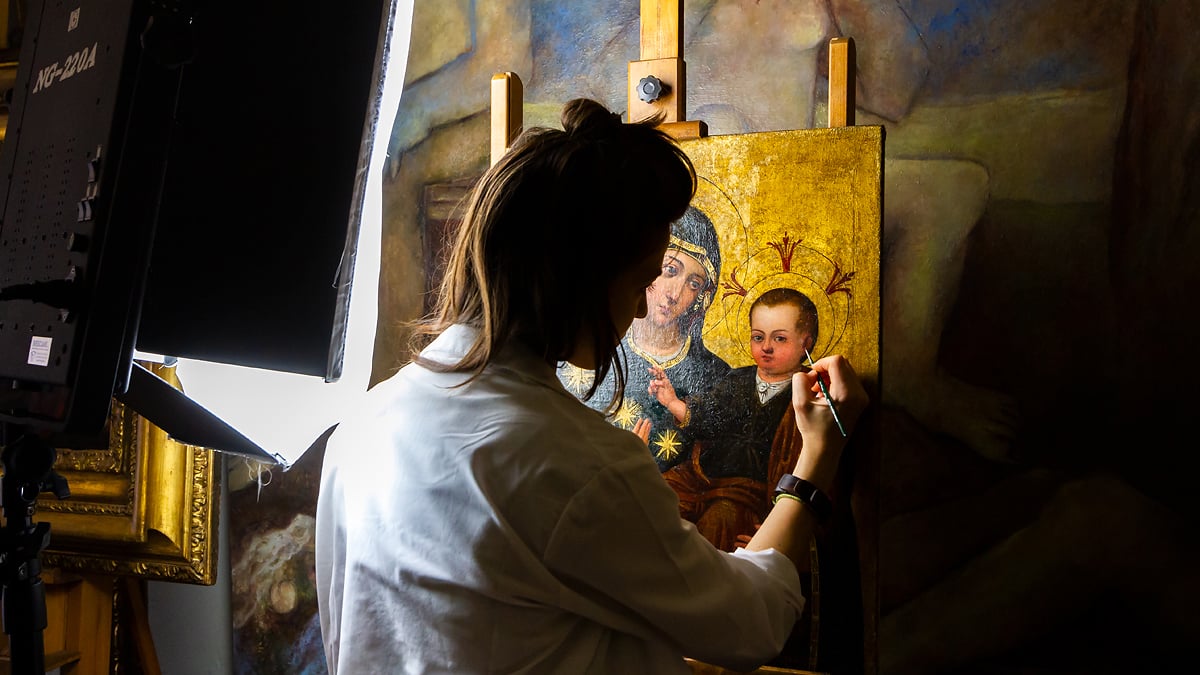
For nearly 30 years, conservators Valeria Merlini and Daniela Storti have worked to restore some of art history’s greatest treasures, notably staging the first open conservation project in Italy with their in situ work on Caravaggio’s The Pilgrims’ Madonna in the Church of Sant’Agostino in Rome in 1999.
Now, for the first time, art lovers have the chance to step into the pair’s Roman lab, where an all-female team works painstakingly to preserve paintings that are hundreds of years old.
Earlier this year, the conservation studio partnered with tour company Roma Experience to offer “Restoring Caravaggio,” a public tour of the lab in which visitors can learn about the delicate and time-consuming art and science of conservation.
It probably isn’t how you picture it. You might have seen, for instance, the viral video posted to Twitter by British art historian, dealer, and TV host Philip Mould, in which he takes a large cotton swab to a heavily varnished painting, instantly revealing bold, lifelike colors beneath the previously dulled surface.
Valeria Merlini cleaning a section of a 16th-century oil-on-panel work by Fabrizio Santafede. Photo courtesy of Studio Merlini Storti.
“It made us cry! It was terrible,” joked Arianna Pavoncello, a coordinator at the Merlini Storti lab, during a tour of the studio. “Those kinds of videos go viral and people think that’s what restoration is—and it’s not. It’s not like, ‘that took ten minutes!'”
Instead, there’s a careful process of trial and error, with restorers meticulously testing different sections of a painting to see how they react to a cleaning. Merlini gave us a demonstration, working slowly on a very small section of a canvas, methodically marking the treated area in chalk.
Merlini originally wanted to be a doctor—and in some ways, she’s not that far off. “She’s a doctor of paintings!” Pavoncello quipped.
Instead, Merlini went to art school. “My professor said to me: ‘You are not an artist, but you could become a good restorer,'” she recalled. It was tough news to bear, but it set her on the right path. Merlini and Storti first teamed up in 1989, and moved to their current lab in Rome in 2000, after their breakthrough work on the Caravaggio, during which they shared detailed reports on the painting’s condition online, which was unheard of at the time.
Caravaggio, The Pilgrims’ Madonna, from Rome’s Church of Sant’Agostino, restored by Studio Merlini Storti in 1999. Courtesy of Studio Merlini Storti.
During the tour, as Merlini was carefully cleaning, restorer and technician Chiara Scognamiglio was hard at work just across the room. With the tiniest of brushes, she was touching up a virgin-and-child painting, working to match the colors exactly. To ensure that her application could be efficiently undone if necessary, she used paint that had varnish as a binder, deliberately avoiding the same oil or tempera paint employed by the original artist.
“One of the principles for restorers is that your work has to be easily removable, so that other restorers in the future can see clearly where your restoration was done and remove it before beginning their own work,” Pavoncello said.
Scaffolding used by conservators during the public restoration of The Pilgrim’s Madonna by Caravaggio. Photo courtesy of Studio Merlini Storti.
Much of the studio’s work is done in the lab, but sometimes, important projects are undertaken in public, which can help teach people about the restoration process.
“In the lab, you have more tools and it’s a place that you can work in a tranquil environment. But on the other hand, it’s very important to [give] people the pleasure of looking at these important paintings,” Pavoncello explained, noting that paintings in churches are devotional objects and that people often travel internationally to see them.
The three-hour Roma Experience tour also takes you to see the finished results of the studio’s work. Within walking distance, there are two Caravaggio paintings restored by the team. (A third, Adoration of the Shepherds, belongs to the Museo Regionale in Messina.) As part of the tour, an art historian provides a detailed account of the Old Master’s highly dramatic life and career, stopping at other nearby churches to show additional examples of his work.
See more photos of the Studio Merlini Storti team and their work below.
Daniela Storti and Valeria Merlini. Photo courtesy of Studio Merlini Storti.
Daniela Storti cleaning Bartolomeo Vivarini’s Triptych Depicting Madonna with Child, Saint George, and Saint Augustine. Photo courtesy of Studio Merlini Storti.
Daniela Storti and a collaborator during the restoration of Giulio Romano’s altarpiece Holy Family. Photo courtesy of Studio Merlini Storti.
Arianna Pavoncello. Photo courtesy of Studio Merlini Storti.
Cleaning sample on The Pilgrim’s Madonna by Caravaggio. Photo courtesy of Studio Merlini Storti.
Chiara Scognamiglio. Photo courtesy of Studio Merlini Storti.
Valeria Merlini and a collaborator during the restoration of Caravaggio’s Conversion of Saul. Photo courtesy of Studio Merlini Storti.
Retouching a painting. Photo courtesy of Studio Merlini Storti.
Arianna Pavoncello shows visitors a cleaning sample on an in-progress restoration. Photo courtesy of Studio Merlini Storti.
Before-and-after details of The Pilgrim’s Madonna by Caravaggio. Photo courtesy of Studio Merlini Storti.
Tickets for the Restoring Caravaggio tour with Roma Experience are €245 ($278).